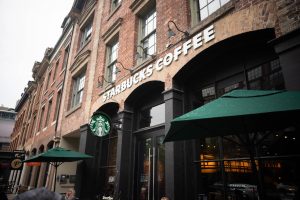Starbucks’ Holiday Cups – Naughty or Nice?
Published on December 4, 2019, at 9:30 p.m.
by Ashby Brown.
It’s that time again. Leaves are changing and the cold air is setting in — it’s the holiday season! Brands have important roles to play throughout this season, and the coffee-selling giant Starbucks is no stranger to this reality.

Starbucks, specifically its holiday cups, has played an interesting role in the media for the past couple of decades. Beginning in 1997, Starbucks created specially designed cups for the holiday season, usually featuring illustrations of snowflakes, reindeer, ornaments and other holiday items. These cups established a fun tradition for Starbucks to interact with its customers — before the company became scrutinized for changing its holiday cup design.
In fall 2015, Starbucks debuted a red ombré cup, ditching the traditional Christmas illustrations for a more inclusive holiday design. Jeffrey Fields, Starbucks’ vice president of design and content, said, “This year we wanted to usher in the holidays with a purity of design that welcomes all of our stories.” This cup of inclusion and acceptance was greeted with vast criticism from many customers missing the “quintessential” Christmas illustrations.
In protest, one man created a movement against the 2015 holiday cup. Using the hashtag #MerryChristmasStarbucks, customers across the nation boycotted the cup for taking away the Christmas spirit. One thing that many people didn’t think about? The many other cultural holidays celebrated around the same time.
Time went by, and Starbucks continued to design with inclusion in mind. In 2017, Starbucks created a white, almost coloring-book like cup with different holiday images. Leanne Fremar, the executive creative director for Starbucks, said, “We’re inviting everyone to color in the holidays in a way that’s meaningful to them.”

Instead of a positive reaction, Starbucks was, once again, greeted with controversy. While reintroducing Christmas and other holiday symbols, the cup featured two interlinking hands, but the image was perceived by some to be pushing a “gay agenda.” This story became so popular that The New York Times even covered the controversy.
This year, Starbucks’ main design features red and green scattered letters that spell “Merry Coffee.” Has Starbucks drifted away from its inclusive ideas? Will a new controversy arise soon? Only time will tell.
The bottom line is this: No matter what, if you represent a forward-facing company, know how to strategize messages and materials for your target audiences during the holidays. Knowing your key publics is important, but make sure not to put your audiences in boxes, gift-wrapped or not.




